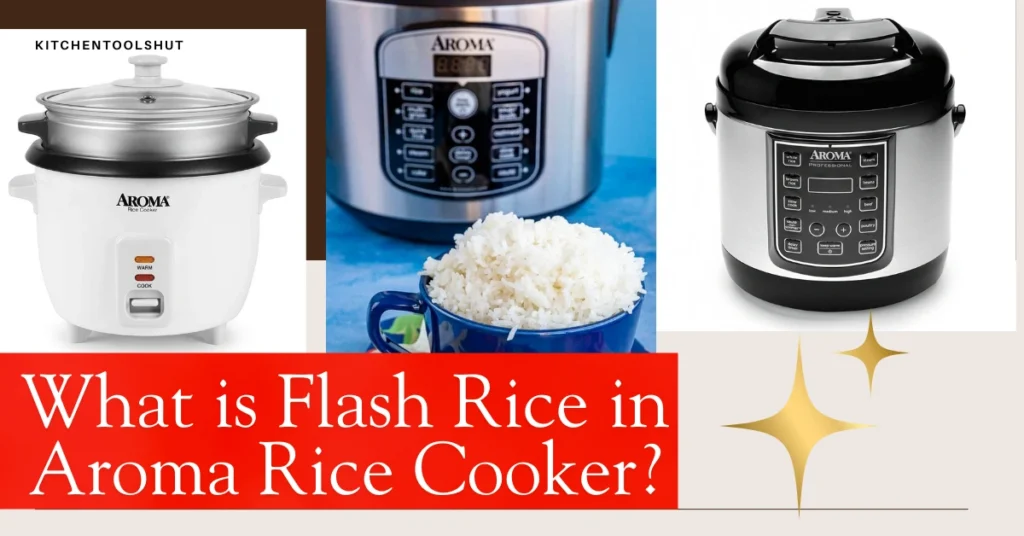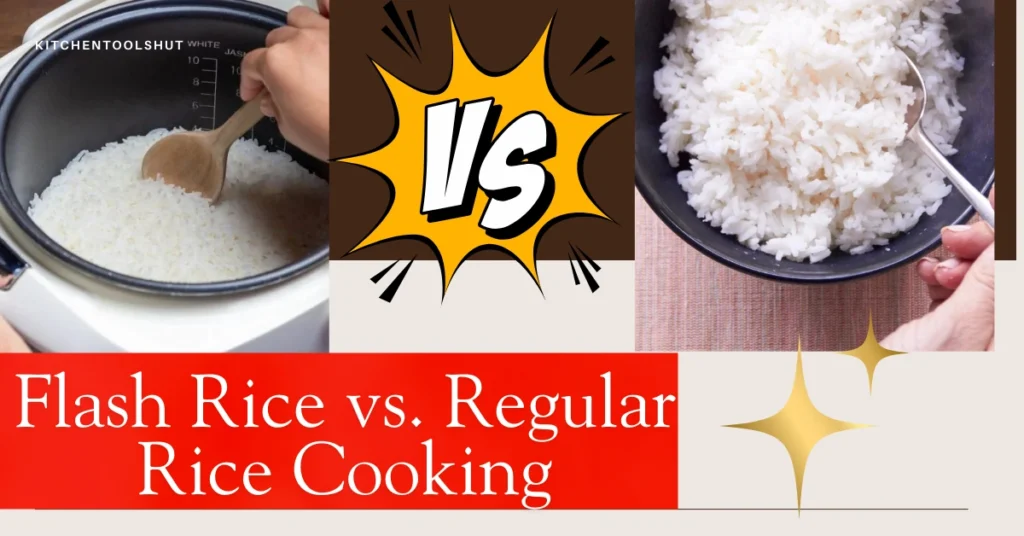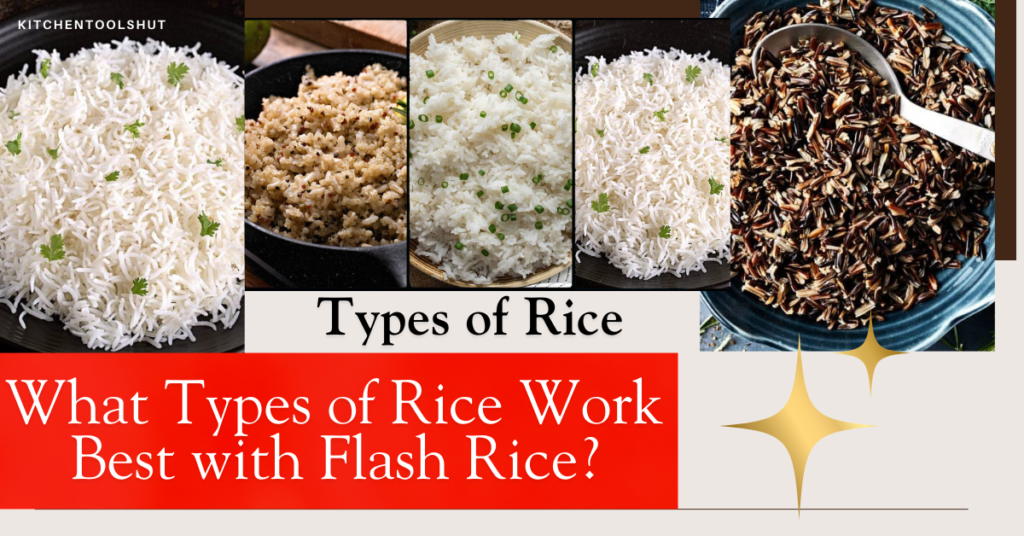Rice cookers are a game-changer in the kitchen—quick, easy, and hands-off. But if you’ve ever spotted the “flash rice” button and wondered, What is flash rice in rice cooker? you’re not alone. It’s a feature that promises to cook rice faster, but what exactly does it do, and when should you use it?
In this article, I’ll walk you through what flash rice is, how it works, and how to get the best results from this speedy setting. Whether you’re a rice cooker newbie or just looking to streamline your cooking, keep reading to unlock the full potential of your appliance.
What is Flash Rice in Rice Cooker?
Ever seen the “Flash Rice” button on your rice cooker? I did, and I was curious. Does it cook rice at lightning speed? Well, kind of!
Flash Rice is a quick-cook setting. It uses high heat to make white rice faster. Instead of the slow soak-and-steam method, it speeds things up. Your rice cooks in half the time!
It’s great when you’re in a hurry. But it won’t work well for brown or sticky rice. Those need more time to soften.
What Does Flash Rice Mean in a Rice Cooker?
If you’ve ever wondered what “flash rice” means in a rice cooker, you’re not alone. It’s a setting that speeds up the cooking process, cooking rice faster than the usual method. Flash rice works by raising the temperature, so it cooks the rice in a shorter time. The result? Firmer, less sticky rice than what you get from regular cooking.
In simple terms, flash rice uses higher heat to cook your rice quickly. This is perfect when you’re in a rush. However, the texture is different from slower cooking methods. The rice will be firmer, which is great for dishes where the rice needs to keep its shape, like stir-fries or grain bowls.
So, next time you see the flash rice button, you’ll know it’s meant to save time and give you rice with a firmer texture, ideal for certain meals.
What Does the Flash Rice Button Do on a Rice Cooker?
Ever wondered what the flash rice button does? It makes cooking rice faster. When you press it, the rice cooker heats up quickly. This means the rice cooks in less time.
The flash rice setting raises the temperature. This makes the rice firmer and less sticky. It’s perfect when you need rice fast. It’s great for stir-fries or dishes where the rice should stay separate.
The flash rice button is all about speed. It helps you save time without losing too much in taste or texture. So, when you’re in a rush, this setting is your friend.
Read Also: What Air Fryer Heats to 420°? Best Models Revealed

What is Flash Rice in Aroma Rice Cooker?
If you have an Aroma rice cooker, you’ve likely seen the “Flash Rice” button. But what does it do? Let me break it down for you.
The flash rice button makes cooking faster. When you press it, the rice cooker heats up quickly. This means your rice cooks in less time—about 15-20 minutes, depending on how much you make. Normally, cooking rice takes 25-30 minutes, so this is a big time-saver.
How does it work? The flash rice setting raises the temperature. This cooks the rice faster and makes it firmer, not soft or sticky. It’s perfect for dishes like stir-fries or grain bowls, where you want the rice to hold its shape.
Aroma’s flash rice function is great. It’s quick, and the texture is just right. Compared to other rice cookers, it stands out because it saves time without losing quality. You’ll find similar settings on other models, but Aroma does it well.
When Should You Use the Flash Rice Setting?
The flash rice setting is great when you’re in a rush. It helps you cook rice faster. If you’re running late for breakfast or dinner, this feature is a lifesaver.
I often use it for quick meals like stir-fries or grain bowls. The rice comes out firmer and less sticky. This is perfect when you want the rice to stay separate. It helps speed up your cooking without losing too much texture.
But there are times when you shouldn’t use flash rice. If you’re cooking brown rice or sticky rice, it’s best to use the regular setting. These rice types need more time to cook. Flash rice can make them too firm and dry.

Flash Rice vs. Regular Rice Cooking: Key Differences
Flash rice and regular rice cooking are like two sides of the same coin, but with key differences. Let’s break them down.
Speed:
The biggest difference between flash rice and regular cooking is speed. Flash rice is faster. It cooks rice in about 15-20 minutes, while regular cooking can take 25-30 minutes, depending on the type of rice. If you’re in a hurry, flash rice is a game-changer.
Texture:
When it comes to texture, there’s a noticeable difference. Flash rice gives you firmer grains. The rice is less sticky, making it perfect for dishes like stir-fries where you want the rice to stay separate. Regular cooking, on the other hand, gives you softer, stickier rice. This is great for meals like sushi or when you want the rice to stick together.
Personal Experience:
I’ve used both methods, and I’ll tell you, it really depends on the meal. For weeknight stir-fries, I’m all about the flash rice. The rice comes out just the way I want—separate and firm. But for comfort meals like curry, I stick with the regular setting. The softer, stickier texture works better with the sauce. It’s about knowing what works for your dish.
In short, flash rice is all about speed and firmness, while regular cooking gives you time for softer, stickier rice. Both have their place in your kitchen—it’s all about picking the right method for the dish you’re making!
Benefits of Using the Flash Rice Function
The flash rice function on your rice cooker is a real time-saver. Here’s why you’ll love it:
Quick Cooking:
The flash rice button cooks rice fast. Instead of waiting 25-30 minutes, it takes just 15-20 minutes. If you’re in a hurry, this is a game-changer.
Easy to Use:
Using the flash rice function is simple. Just press one button, and your rice cooker takes care of the rest. You can walk away and focus on other things. It’s perfect for busy days.
Firm Rice:
The flash rice setting makes rice firmer. It’s great for dishes like stir-fries, where you want the rice to stay separate and not clump together. It won’t be sticky like regular rice.
So, the flash rice function helps you cook faster, with less effort. It’s great for quick meals and dishes where you need firm rice.

What Types of Rice Work Best with Flash Rice?
When it comes to the flash rice setting, not all rice types are created equal. Some rice varieties work perfectly with the quick-cooking function, while others need more time to cook properly. Here’s what you need to know
Best Rice for Flash Rice:
- White Rice: This is the go-to rice for the flash rice setting. It cooks up quickly and has a nice firm texture, perfect for dishes like stir-fries or grain bowls.
- Jasmine Rice: If you’re craving a fragrant, fluffy rice that’s not too sticky, jasmine rice shines on the flash rice setting. It cooks fast and keeps its shape well.
- Basmati Rice: Similar to jasmine, basmati cooks quickly and has long, separate grains, making it ideal for quick meals like pilafs or side dishes.
Rice to Avoid with Flash Rice:
- Brown Rice: Brown rice requires more time to cook because of its tough outer layer. Flash rice can leave it too firm or undercooked, so it’s better to stick with the regular setting here.
- Wild Rice: Wild rice is also tougher and needs a longer cooking time to soften up properly. Flash rice won’t give it the proper texture.
Pro Tip: For quick meals that call for fluffy rice but don’t need that sticky, comforting texture, stick with white, jasmine, or basmati rice on the flash rice setting. For heartier grains like brown rice, take the extra time with the regular setting to ensure it cooks through.
Read Also: How Often to Change Oil in a Deep Fryer? Expert Tips
My Personal Experience with Flash Rice
At first, I wasn’t sure about the “flash rice” button on my rice cooker. I always used the regular setting. But one night, I was in a rush and decided to give it a try.
I was making stir-fry and needed rice fast. So, I pressed the flash rice button. In just 20 minutes, the rice was done. It was firmer than usual, which worked perfectly for my stir-fry. The rice didn’t clump together, and it stayed separate.
After that, I started using the flash rice button all the time. It’s quick and easy. The rice cooks fast and tastes great. I use it most for white, jasmine, or basmati rice.
But, I’ve learned that flash rice isn’t right for every type. Brown rice needs more time to cook, so I still use the regular setting for that.
Now, I always use flash rice when I’m in a hurry. It saves time, and the rice comes out just the way I want. If you need rice in a hurry, give it a try!
Conclusion: Try Flash Rice for Fast, Perfect Rice
Flash rice is quick. It cooks rice faster, giving it a firm texture. This is perfect for busy days when you need rice in a hurry. The flash rice setting works best with white rice, jasmine, and basmati. These types cook quickly and keep their shape.
If you’re in a rush, press the flash rice button. It saves you time and still gives you great rice. It’s ideal for stir-fries or grain bowls. But, if you’re cooking brown rice or sticky rice, use the regular setting. These types need more time.
Give it a try next time. Flash rice can change how you cook. It’s quick and easy. Plus, it’s perfect for meals on the go.
FAQS
What is flash rice in a rice cooker?
This is an essential question, as it explains the core concept of the feature and provides a clear definition for readers who are unfamiliar with the term. It aligns directly with the focus of your article.
How does the flash rice button work on a rice cooker?
Since you explain the functionality of the flash rice button in detail, this question clarifies how it works, which is key for readers looking for more specifics about the feature.
When should I use the flash rice setting?
Your article includes practical advice on when to use the flash rice setting, making this FAQ valuable for readers who need guidance on its application.
What types of rice work best with the flash rice setting?
This FAQ would directly help readers understand which rice types are suited for flash rice, based on your article’s detailed explanation of rice varieties like white, jasmine, and basmati.
With over 8 years of experience in the culinary and kitchen tools industry, I specializes in finding/reviewing high-performance cookware and innovative kitchen technology. My expert insights help both chefs and home cooks find efficient, user-friendly tools that enhance their cooking experience and elevate kitchen efficiency. More about Raimul…

